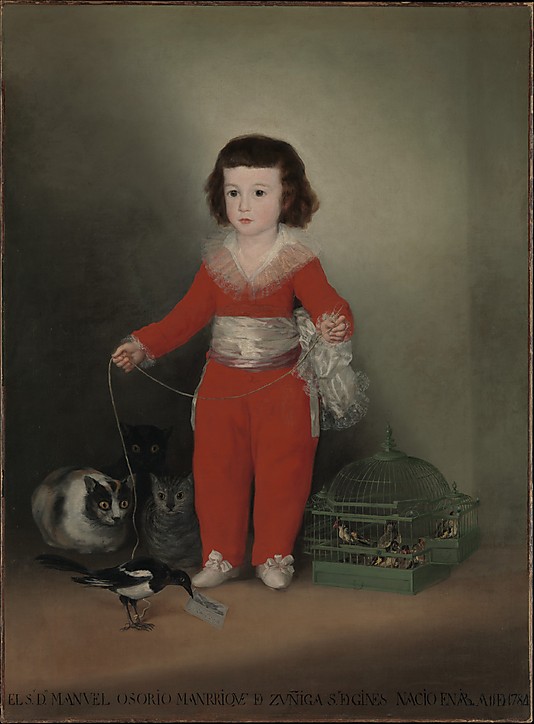Art, royal children, and time
Yesterday I wrote a post featuring this charming photo of the young and growing royal family:
What do I like about the photo? It’s not really the subject matter; I’m not so much into the royals, although I think this particular crew seems unusually likeable as well as photogenic. For me, it’s more about the picture: I like the framing in the window.
But the thing that I find most engaging about it is the interplay between the baby and the dog, in contrast with the usual formality of an official royal portrait. What is the dog thinking? Is it loyally and steadfastly standing guard? Is it ignoring the baby and looking past him to something interesting in the distance, a squirrel perhaps?
The baby’s fascination, though, is clearly with the dog itself.
And the whole thing reminded me of another, somewhat darker portrait, one by Goya. Goya was a court painter known for being remarkably unflattering to his royal sitters, but this portrait of the very young Manuel Osorio Manrique de Zué±iga is different, and far gentler:
Like many children of the time (late eighteenth century) the boy did not live to adulthood; he died around the age of eight. The portrait foreshadows this in the lower left of the picture, where the animals are carrying on their own drama:
The sitter is the son of the Count and Countess of Altamira. Outfitted in a splendid red costume, he is shown playing with a pet magpie (which holds the painter’s calling card in its beak), a cage full of finches, and three wide-eyed cats. In Christian art birds frequently symbolize the soul, and in Baroque art caged birds are symbolic of innocence. Goya may have intended this portrait as an illustration of the frail boundaries that separate the child’s world from the forces of evil or as a commentary on the fleeting nature of innocence and youth.
There’s also this:
…[Y]ou sense “Goya’s awareness of how contingent life is,” to quote the critic Robert Hughes.
That awareness is certainly heightened by…our knowledge of Goya’s own losses. (At least seven of his offspring died in infancy.) Although the dark mood of later Goya is much in evidence here, the painting has talismanic properties, as if the image of Manuel could somehow warn or protect other children.
Children and animals are cute, but they are much more than cute. They are extraordinarily precious and also vulnerable, and artists (be they painters or photographers) know that, as do parents.



I’d argue the cats focus is on the string, don’t you think?
Too much of art commentary is speculative (“Goya may have intended”) or projection, even absurd projection (“the painting has talismanic properties”). This stuff is simply babble with which to cover pages, even without “perhaps” or “arguably” thrown in.
As for me, what is remarkable is the eyes of the cats; I can feel them looking at the bird, though their bodies lack the pre-leap lowered crouch posture.
The kid? His pose merely exhibits the glory of his costume, his rank.
But back to the Royals: that is a fine portrait of a nuclear family -man,wife,kid,dog- devoid of flourish and pomposity. With the middle class and its values sinking throughout the West, the Royals are symbolically being lowered as well; not really Royals, just the nice young family you wish you had next door instead of those awful tatooed kids with their sixpacks coming and going at all hours.
But the thing that I find most engaging about it is the interplay between the baby and the dog, in contrast with the usual formality of an official royal portrait.
The dog and the baby also struck my attention. Judging from my observations of infants and dogs, my guess is that the dog is generally as interested in interacting with the baby as the baby is in interacting with the dog, though it may not necessarily doing so at the moment. It is amazing how patient dogs can be with toddlers who tug and pull at them.
While agree with Don Carlos about speculating too much about art- looking at art is an emotional/spiritual, not an intellectual experience- I will post my reaction.
Birds focusing in the shadows- death in the shadows. The child in red is going to float away- fly away- as if the impending death of the birds predicts his death. Birds fly away all the time; the child will fly away at the time of his death.
The light area around the child’s head- reminds of a halo.
Or the fog/cloud of death in the background about to envelop the child.
What the heck, it is a pretty picture that gets your mind a racing. That’s all an artist wants.
The first written art critique I have written since an AP course in high school. And probably the last.
http://www.youtube.com/watch?v=VCVIJ7b0GyA The Blues Project: Fly Away
http://www.youtube.com/watch?v=-L26dFqRFiw Willie Nelson: I’ll Fly Away
The baby’s fascination, though, is clearly with the dog itself.
Indeed. I imagine the caption might be: let’s blow this pop stand and go chase squirrels in the park.
Cat’s going to eat that bird.
It is a nicely framed photo, and they look like a lovely young family, full of life and love. Good for them.